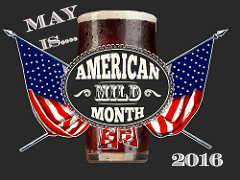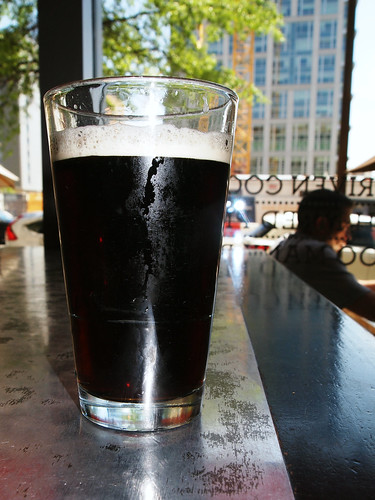It's nearly the middle of May, and I have yet to drink one drop of Mild Ale this month. None of the breweries in Georgia brew one. And that's a pity. They haven't heard the news. [Happy update: They have!]
It's the second annual American Mild Month. Throughout the month of May and throughout the rest of the United States, breweries are brewing American Mild Ales.
American Mild Month is the idea of Alistair Reece: an ex-pat Scotsman and past Prague resident, who now lives in Virginia in the U.S., where he blogs at Fuggled. The Campaign for Real Ale (CAMRA) has been hosting a "May is for Milds" campaign for many years. So, Reece thought, why not here in the U.S.?
What is Mild Ale? Start with the concept of 'session' beer. Lew Bryson, a long-time fighter for 'session' beer, defines American Session Ale as:
- 4.5% alcohol by volume or less
- flavorful enough to be interesting
- balanced enough for multiple pints
- conducive to conversation
- reasonably priced
Before the 20th century (and even into it), Mild Ale referred to something very different than it does today: then, a non-aged ale, often quite strong. Today, it's a low alcohol, not bitter, often darker ale. Of Mild's character, I'll defer to British authors Jessica Bloak and Ray Bailey:
First, it has to put sweet malt and flavours from sugar at the forefront, but that doesn’t have to mean that it has to be sickly or lacking in character. Bitterness can work, but excessive perfume just seems wrong. Roastiness also jars, suggesting that some brewers remain in thrall to out-of-date history that declares mild to be a degeneration of porter, which it isn’t.
Reece interprets American Mild as a form of modern Mild Ale, but with an American twist: a "restrained, darkish ale, with gentle hopping and a clean finish so that the malt and what [American] hops are present shine through." I should add "would be," because American Mild has not yet been 'recognized' by this nation's beer-style poobahs.
- Alcohol-content-by-volume (abv) of 4.5% or less.
- Color greater than 17 SRM (i.e., darker than a golden ale).
- Bitterness level of 30 International Bittering Units (IBU) or fewer. Thus, more bitter than an English Mild, but much less hoppy than an American IPA.
- American —thus, not-so-fruity— ale yeast strains.
American Mild is not a hop bomb, but neither need it be a hop free zone. 'Low' is not the same as 'none;' it is all about restraint, and with the wide variety of American hops available the range of hop flavors is actually quite broad, whether its the spiciness of Cluster, the grapefruit of Amarillo, or the tropical fruit of El Dorado, there is room here for differentiation, and dry hopping is ok too.
Remember though, before going crazy with the hops, an American Mild is not a Session IPA, or a Session Cascadian Dark Ale, it's still a mild. Traditional English milds top out at 25 IBUs, but for an American Mild we would suggest an upper limit of 30 IBUs.
Alcoholic restraint is a hallmark of the modern mild ale, and we believe that an American mild should follow that tradition, topping out at 4.5% abv. We imagine most American milds would fall between 3.5% and 4.5% abv.
One major departure from the English mild style in a theoretical American mild is the yeast. The classic American yeast strain used by many an American craft brewery is known for being very clean, allowing the other ingredients to shine through without contributing the fruity flavors of the British yeasts.
American Mild Ale is NOT a 'session' IPA; it is not an over-hopped ale; it does not contain alcohol of greater than 4.5% by volume. Do any of those things, and you're playing with 'session' semantics.
Do things right, and Mild Ale — 'more-ish' and (ugh, how I detest this word) 'drinkable'— might just be the quintessential 'session' beer. So, why isn't your brewery brewing one?
Some brewers will tell you that the word "mild" itself dampens sales, as in mundane or not dangerous enough. A few years back, a Virginia brewer was experiencing slow sales of his draft and cask Dark Mild Ale, called such. He re-christened it as Atomic Monkey, and sales boomed.
So, U.S. breweries: call it what you will. Just please brew it! And please serve it cask-conditioned (without extraneous stuff). And please do it, now, in May, or, while you're at it, year-round. Please, and thank you.
-----more-----
- *UPDATE. After I posted, I received this welcome Georgia update from American Mild Month: "Georgia has a mild going on tap today - Monday Night Brewing's Sad Stove Mild in their tap room."
- American Mild Ale:
- Specifications
- Website: www.mildmonth.com
- Facebook: AmericanMildMonth
- Twitter:@MildMonthUS
- Hashtag: #MildMonthUS
- Participating breweries.
- Brewery sign-up form.
- An in-depth examination of modern British Mild Ale, from Jessica Boak and Ray Bailey, at All About Beer: here.
- Irony notwithstanding, these are the specifications for English Mild Ale, as defined by the [U.S.] Brewers Association.
A. Subcategory: English-Style Pale Mild Ale
English Pale Milds are light amber to medium amber. Chill haze is allowable at cold temperatures. Fruity-ester aroma is very low to medium low. Hop aroma is very low or low. Malt flavor dominates the flavor profile. Hop flavor is very low to low. Hop bitterness is very low to low. Very low diacetyl flavors may be appropriate in this low-alcohol beer. Fruity-ester flavor is very low to medium low. Body is low to low-medium.- Original Gravity (°Plato) 1.030-1.036 (7.6-9.0 °Plato)
- Apparent Extract/Final Gravity (°Plato) 1.004-1.008 (1.0-2.1 °Plato)
- Alcohol by Weight (Volume) 2.7%-3.4% (3.4%-4.4%)
- Bitterness (IBU) 10-20
- Color SRM 6-9 (12-18 EBC)
B. Subcategory: English-Style Dark Mild Ale
English Dark Milds are reddish brown to very dark. Fruity-ester aroma is very low to medium low. Malt and caramel are part of the aroma while licorice and roast malt tones may sometimes contribute to aroma profile. Hop aroma is very low. Malt flavor and caramel are part of the flavor profile while licorice and roast malt tones may also contribute. Hop flavor is very low. Hop bitterness is very low to low. Very low diacetyl flavors may be appropriate in this low-alcohol beer. Fruity-ester flavor is very low to medium low. Body is low-medium to medium.- Original Gravity (°Plato) 1.030-1.036 (7.6-9.0 °Plato)
- Apparent Extract/Final Gravity (°Plato) 1.004-1.008 (1.0-2.1 °Plato)
- Alcohol by Weight (Volume) 2.7%-3.4% (3.4%-4.4%)
- Bitterness (IBU) 10-24
- Color SRM 17-34 (34-68 EBC)
- For more from YFGF:
- Follow on Twitter: @Cizauskas.
- Like on Facebook: YoursForGoodFermentables.
- Follow on Flickr: Cizauskas.
- Follow on Instagram: @tcizauskas.












No comments:
Post a Comment
Comment here ...